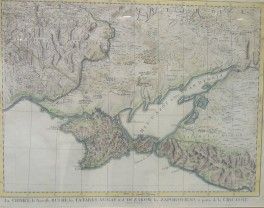 A French map, dating to 1777, of Crimea. Up there is Azov, on the right side, right where the two banks meet. Azov was also known as Tana and Venetians kept a trading colony up to the fall of Constantinople in 1453. Proof of that is that in Venice there is still a Tana Square.
A French map, dating to 1777, of Crimea. Up there is Azov, on the right side, right where the two banks meet. Azov was also known as Tana and Venetians kept a trading colony up to the fall of Constantinople in 1453. Proof of that is that in Venice there is still a Tana Square.
Azov was one of the end of the Silk Road going to China and was controlled by Mongols, also known as Tatars. Venetians and Genoese bough slaves there and had them transported to Genoa and Venice. Then they were re-sold to other parts of Italy.
The mother of Leonardo, Caterina, may have been one of those little girls transported by Venetian ships and then she was sold to Ser Vanni, a wealthy client of Ser Piero Da Vinci, Leonardo’s father.
In 1261 the Byzantine Emperor Michael Palaeologus in 1266 granted exclusivity of trading in the Pontus region to the Genoese admiral Baldo Doria, then he obtained permission to settle there from Mengu Khan. With the arrival of the Genoese, Caffa expanded between 1250 and 1350, evolving from a fishing village into a rich city and, in spite of the great distance, news of China’s upheavals and natural disasters reached this outpost and the trading houses reported back to their headquarters.
By the end of the XIV century, Italians had taken over the trade of slaves. The result was that oriental slaves were a common sight in maritime cities on the shores of the Mediterranean but especially Venice and Genoa. Even on ships of the Holy See there were slaves to man them and this use remained in force up to the XVIII century.
Traditionally Tana (Azov) and Caffa (known as Feodosya or Theodosia) were stepping-stones for crossing Asia and going to China – Marco Polo’s uncle, Matteo Polo, kept a small warehouse there – and it was right there that caravans unloaded spices, medicines, pearls, fabrics and people, to be then moved into continental Europe. From Tana a merchant could safely reach Beijing in eight to twelve months.
